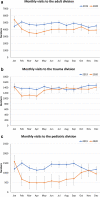Examining patient flow in a tertiary hospital's emergency department at a low coronavirus prevalence region
- PMID: 35896981
- PMCID: PMC9328777
- DOI: 10.1186/s12873-022-00694-6
Examining patient flow in a tertiary hospital's emergency department at a low coronavirus prevalence region
Abstract
Background: Taiwan's successful containment of the COVID-19 outbreak prior to 2021 provided a unique environment for the surveillance of unnecessary emergency medical use. The aim of the study is to examine the impact of the coronavirus disease (COVID-19) pandemic on the patient flow in the emergency department (ED) of a tertiary hospital over 1 year in southern Taiwan, a region with low COVID-19 prevalence.
Methods: Cross-sectional observational study was conducted from January to December 2020. Essential parameters of patient flow in the ED between January and February 2020 and the subsequent 11-month period were compared to data from 2019. Data were analyzed with descriptive statistics, using an independent sample t-test or Mann-Whitney U test, as applicable.
Results: The ED census showed an acute decline (- 30.8%) from January to February 2020, reaching its nadir (- 40.5%) in April 2020. From February to December 2020, there was an average decrease of 20.3% in ED attendance (p < 0.001). The impact was most significant in ambulatory visits, lower-urgency acuity (level III) visits, and pediatric visits, without change in the acuity proportion. The length of stay shortened mainly in the adult division, which typically had an overcrowding problem (median, 5.7-4.4 hours in discharge; 24.8-16.9 hours in hospitalization; p < 0.001). The incidence of 72-hour unscheduled return visits was also reduced (4.1-3.5%, p = 0.002).
Conclusions: In contrast to devastated regions, the impact on the ED patient flow in regions having low COVID-19 prevalence highlights a remodeling process of emergency medical care that would improve overcrowding.
Keywords: COVID-19 pandemic; Emergency department; Low prevalence; Overcrowding; Patient flow.
© 2022. The Author(s).
Conflict of interest statement
The authors declare that they have no competing interests.
Figures





Similar articles
-
Differences in Characteristics and Length of Stay of Elderly Emergency Patients before and after the Outbreak of COVID-19.Int J Environ Res Public Health. 2023 Jan 9;20(2):1162. doi: 10.3390/ijerph20021162. Int J Environ Res Public Health. 2023. PMID: 36673917 Free PMC article.
-
The Effect of the COVID-19 Outbreak on Trauma-Related Visits to a Tertiary Hospital Emergency Department.Isr Med Assoc J. 2021 Feb;23(2):82-86. Isr Med Assoc J. 2021. PMID: 33595211
-
Evaluation of changes in pediatric emergency department utilization during COVID-19 pandemic.Arch Pediatr. 2021 Nov;28(8):677-682. doi: 10.1016/j.arcped.2021.09.014. Epub 2021 Oct 6. Arch Pediatr. 2021. PMID: 34702623 Free PMC article.
-
Impact of the Coronavirus Disease 2019 Pandemic on an Emergency Department Service: Experience at the Largest Tertiary Center in Taiwan.Risk Manag Healthc Policy. 2021 Feb 22;14:771-777. doi: 10.2147/RMHP.S272234. eCollection 2021. Risk Manag Healthc Policy. 2021. PMID: 33654444 Free PMC article.
-
Locked in and locked out: sequelae of a pandemic for distressed and vulnerable teenagers in Ireland : Post-COVID rise in psychiatry assessments of teenagers presenting to the emergency department out-of-hours at an adult Irish tertiary hospital.Ir J Med Sci. 2023 Jun;192(3):1419-1426. doi: 10.1007/s11845-022-03080-0. Epub 2022 Jun 23. Ir J Med Sci. 2023. PMID: 35739358 Free PMC article.
Cited by
-
The COVID-19 Pandemic and Emergencies in Otolaryngology-Head and Neck Surgery: An Analysis of Patients Presenting to Emergency Rooms in South-West Germany: A Bi-Center Study.Diseases. 2024 Aug 22;12(8):194. doi: 10.3390/diseases12080194. Diseases. 2024. PMID: 39195193 Free PMC article.
References
Publication types
MeSH terms
LinkOut - more resources
Full Text Sources
Medical
Miscellaneous

